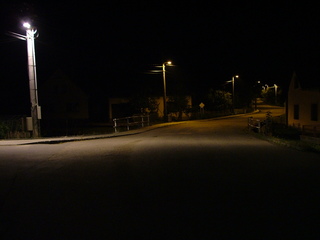 Old view from above,
Old view from above,  new view (lit terrain became dominant)
new view (lit terrain became dominant)
The old luminaires were of varying ages and types. Some used mercury lamps surrounded by a milk collar, another ones had no collar any more (they were but bare MV lamps ponting toward a street), some were old cobras with MV or HPS. Lamp powers were mostly 125 W (for MV), the remaining were 70 W for HPS.
In spring 2006, instead of 38 old luminaires (just 33 were functional), 39 new ones were installed. With two exceptions of post-top type, all were “flat glass” variants of the corresponding luminaire type. They offer excellent glare reduction for pedestrians and drivers, with a pronounced cut-off at about 70 degrees from nadir. They are fully shielded, i.e., obeying the limit of emitting no more than 0 cd/klm horizontally and above that. (See ev. *.txt and *.tab files)
Electric consumption of the lighting system fell by one third from the original 4.6 kW to 3.0 kW. Illuminances of the streets increased two to three times, respecting the Czech road lighting standards. However,
The two exceptions are two post-top luminaires at the centre of the village, with up to ten candelas per kilolumen at or above 90 degrees and 70 W white lamp inside; these were installed instead of horrible bare lamps having some 80 cd/klm at these directions, a tremendous improvement.
The replacement was made very carefully, using libella during montage, to position the luminaires really horizontally. The local electrician Karel Slamecka, who mounted them, adapted the tilted luminaire holders (no without tilt were available on the Czech market) cleverly to make them zero-tilt.
There is still a room for making the lighting system even better. We (i.e., also the municipality and the sponsor) will work on it. However, the current change from the old lighting to the new one means tremendous improvement. Seeing the village from any slope above it made me happy: this is what I have taught about since so many years and now I saw it, the first time in my life!
A telling comparison of the old and new installation can be offered as pairs of images selected from subdirectories:
 Old view from above,
Old view from above,
 new view (lit terrain became dominant)
new view (lit terrain became dominant)
 Old view from the village centre,
Old view from the village centre,
 new view (almost no glare, much better uniformity; )
(The view is from a larger distance.)
new view (almost no glare, much better uniformity; )
(The view is from a larger distance.)
By clicking on the images, an overview leading to photometric images and data appears. The photometric method employed for research is outlined within a lecture (9 MB pdf) “Digital Imaging Photometry with Common Cameras – Methods, Results and Perspectives” held at the IAU Commission 50 meeting in Prague, Aug 23, 2006. For the method itself, there is a directory http://amper.ped.muni.cz/light/luminance
Jenik Hollan